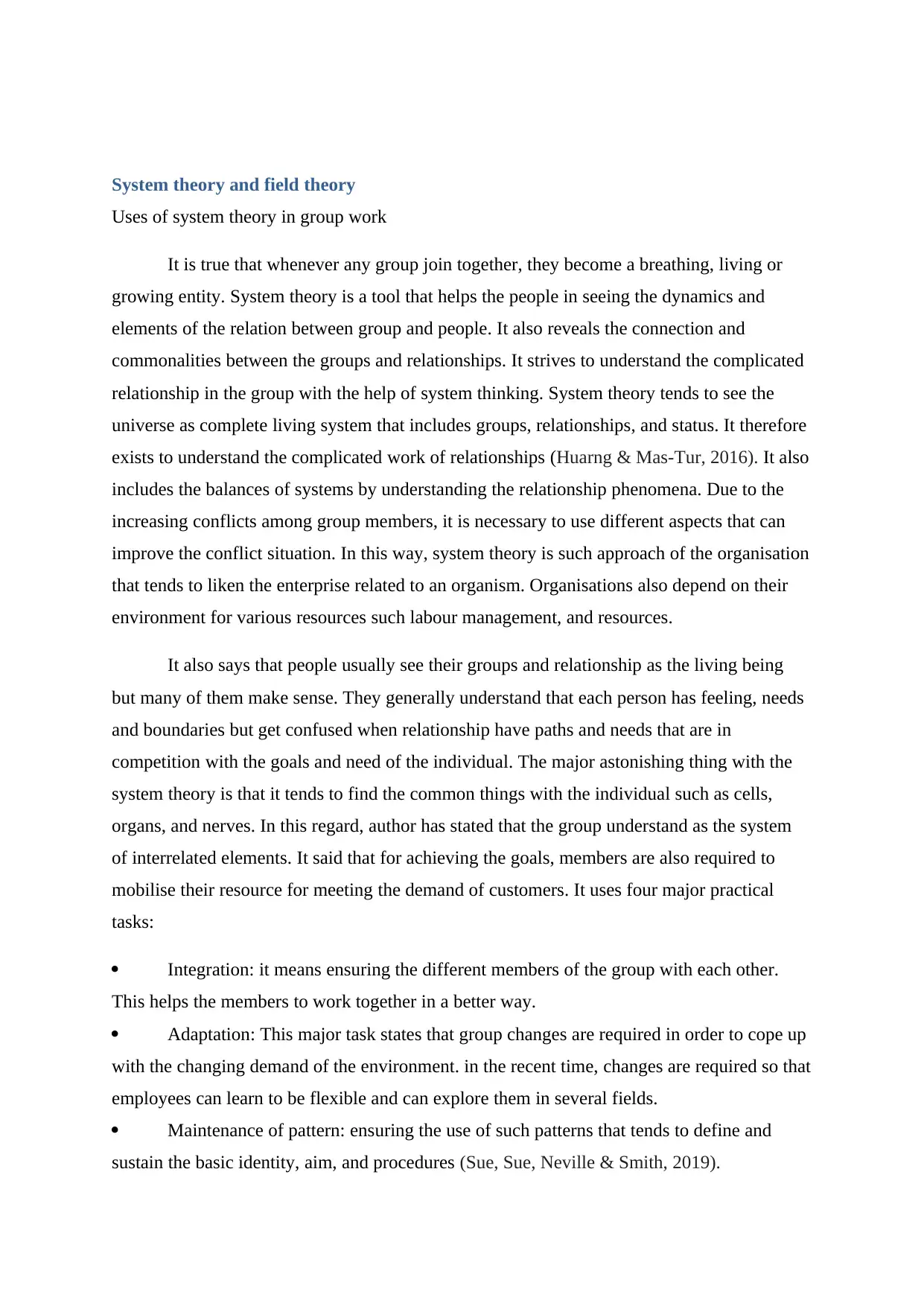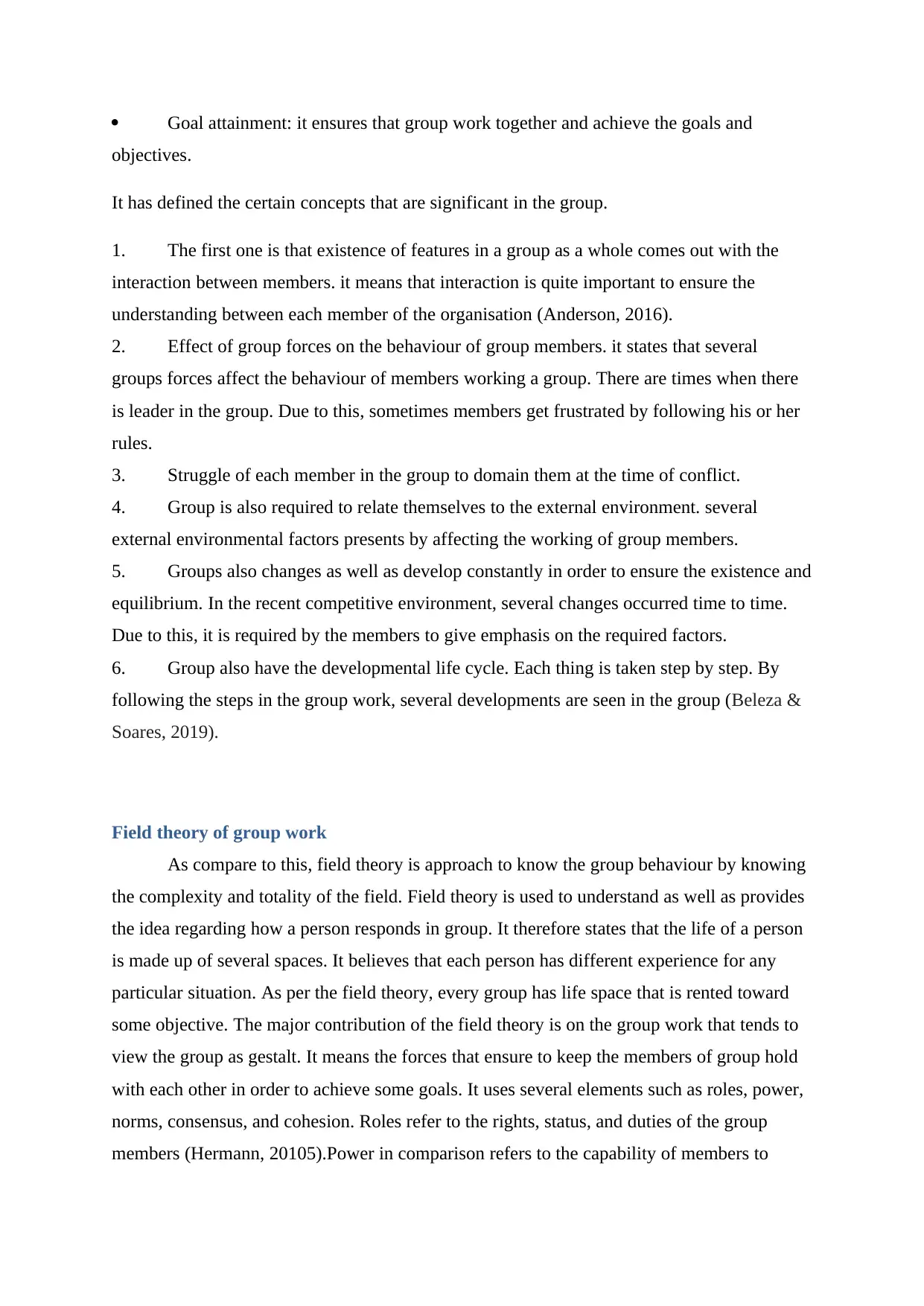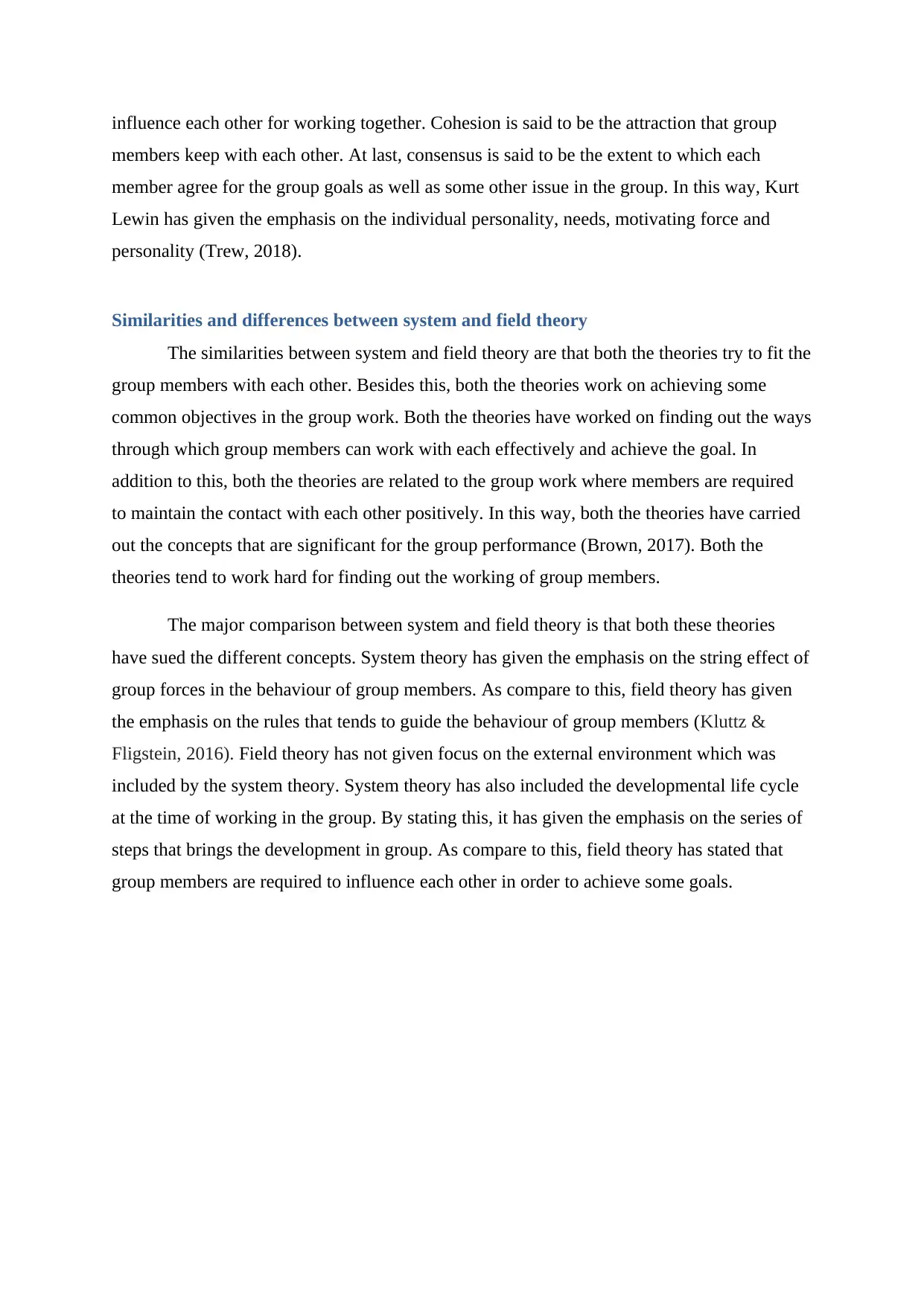System Theory and Field Theory: Understanding Group Dynamics Better
VerifiedAdded on 2022/11/10
|5
|1510
|297
Essay
AI Summary
This essay provides a detailed analysis of system theory and field theory in the context of group work, exploring their respective concepts, applications, similarities, and differences. System theory is presented as a tool for understanding the dynamics and relationships within a group, emphasizing integration, adaptation, pattern maintenance, and goal attainment. It highlights the significance of interaction among group members and the impact of group forces on individual behavior. Field theory, on the other hand, focuses on understanding group behavior by examining the complexity and totality of the field, viewing the group as a gestalt with elements like roles, power, norms, consensus, and cohesion. The essay concludes by comparing the two theories, noting their shared goal of improving group effectiveness while also highlighting their differing approaches and concepts, particularly regarding the influence of external environments and developmental life cycles. Desklib provides access to this essay along with a wealth of other study resources for students.

qwertyuiopasdfghjklzxcvbnmqw
ertyuiopasdfghjklzxcvbnmqwert
yuiopasdfghjklzxcvbnmqwertyui
opasdfghjklzxcvbnmqwertyuiop
asdfghjklzxcvbnmqwertyuiopasd
fghjklzxcvbnmqwertyuiopasdfgh
jklzxcvbnmqwertyuiopasdfghjkl
zxcvbnmqwertyuiopasdfghjklzxc
vbnmqwertyuiopasdfghjklzxcvb
nmqwertyuiopasdfghjklzxcvbnm
qwertyuiopasdfghjklzxcvbnmqw
ertyuiopasdfghjklzxcvbnmqwert
yuiopasdfghjklzxcvbnmqwertyui
opasdfghjklzxcvbnmqwertyuiop
asdfghjklzxcvbnmqwertyuiopasd
fghjklzxcvbnmqwertyuiopasdfgh
jklzxcvbnmrtyuiopasdfghjklzxcv
OB
ertyuiopasdfghjklzxcvbnmqwert
yuiopasdfghjklzxcvbnmqwertyui
opasdfghjklzxcvbnmqwertyuiop
asdfghjklzxcvbnmqwertyuiopasd
fghjklzxcvbnmqwertyuiopasdfgh
jklzxcvbnmqwertyuiopasdfghjkl
zxcvbnmqwertyuiopasdfghjklzxc
vbnmqwertyuiopasdfghjklzxcvb
nmqwertyuiopasdfghjklzxcvbnm
qwertyuiopasdfghjklzxcvbnmqw
ertyuiopasdfghjklzxcvbnmqwert
yuiopasdfghjklzxcvbnmqwertyui
opasdfghjklzxcvbnmqwertyuiop
asdfghjklzxcvbnmqwertyuiopasd
fghjklzxcvbnmqwertyuiopasdfgh
jklzxcvbnmrtyuiopasdfghjklzxcv
OB
Paraphrase This Document
Need a fresh take? Get an instant paraphrase of this document with our AI Paraphraser

System theory and field theory
Uses of system theory in group work
It is true that whenever any group join together, they become a breathing, living or
growing entity. System theory is a tool that helps the people in seeing the dynamics and
elements of the relation between group and people. It also reveals the connection and
commonalities between the groups and relationships. It strives to understand the complicated
relationship in the group with the help of system thinking. System theory tends to see the
universe as complete living system that includes groups, relationships, and status. It therefore
exists to understand the complicated work of relationships (Huarng & Mas-Tur, 2016). It also
includes the balances of systems by understanding the relationship phenomena. Due to the
increasing conflicts among group members, it is necessary to use different aspects that can
improve the conflict situation. In this way, system theory is such approach of the organisation
that tends to liken the enterprise related to an organism. Organisations also depend on their
environment for various resources such labour management, and resources.
It also says that people usually see their groups and relationship as the living being
but many of them make sense. They generally understand that each person has feeling, needs
and boundaries but get confused when relationship have paths and needs that are in
competition with the goals and need of the individual. The major astonishing thing with the
system theory is that it tends to find the common things with the individual such as cells,
organs, and nerves. In this regard, author has stated that the group understand as the system
of interrelated elements. It said that for achieving the goals, members are also required to
mobilise their resource for meeting the demand of customers. It uses four major practical
tasks:
Integration: it means ensuring the different members of the group with each other.
This helps the members to work together in a better way.
Adaptation: This major task states that group changes are required in order to cope up
with the changing demand of the environment. in the recent time, changes are required so that
employees can learn to be flexible and can explore them in several fields.
Maintenance of pattern: ensuring the use of such patterns that tends to define and
sustain the basic identity, aim, and procedures (Sue, Sue, Neville & Smith, 2019).
Uses of system theory in group work
It is true that whenever any group join together, they become a breathing, living or
growing entity. System theory is a tool that helps the people in seeing the dynamics and
elements of the relation between group and people. It also reveals the connection and
commonalities between the groups and relationships. It strives to understand the complicated
relationship in the group with the help of system thinking. System theory tends to see the
universe as complete living system that includes groups, relationships, and status. It therefore
exists to understand the complicated work of relationships (Huarng & Mas-Tur, 2016). It also
includes the balances of systems by understanding the relationship phenomena. Due to the
increasing conflicts among group members, it is necessary to use different aspects that can
improve the conflict situation. In this way, system theory is such approach of the organisation
that tends to liken the enterprise related to an organism. Organisations also depend on their
environment for various resources such labour management, and resources.
It also says that people usually see their groups and relationship as the living being
but many of them make sense. They generally understand that each person has feeling, needs
and boundaries but get confused when relationship have paths and needs that are in
competition with the goals and need of the individual. The major astonishing thing with the
system theory is that it tends to find the common things with the individual such as cells,
organs, and nerves. In this regard, author has stated that the group understand as the system
of interrelated elements. It said that for achieving the goals, members are also required to
mobilise their resource for meeting the demand of customers. It uses four major practical
tasks:
Integration: it means ensuring the different members of the group with each other.
This helps the members to work together in a better way.
Adaptation: This major task states that group changes are required in order to cope up
with the changing demand of the environment. in the recent time, changes are required so that
employees can learn to be flexible and can explore them in several fields.
Maintenance of pattern: ensuring the use of such patterns that tends to define and
sustain the basic identity, aim, and procedures (Sue, Sue, Neville & Smith, 2019).

Goal attainment: it ensures that group work together and achieve the goals and
objectives.
It has defined the certain concepts that are significant in the group.
1. The first one is that existence of features in a group as a whole comes out with the
interaction between members. it means that interaction is quite important to ensure the
understanding between each member of the organisation (Anderson, 2016).
2. Effect of group forces on the behaviour of group members. it states that several
groups forces affect the behaviour of members working a group. There are times when there
is leader in the group. Due to this, sometimes members get frustrated by following his or her
rules.
3. Struggle of each member in the group to domain them at the time of conflict.
4. Group is also required to relate themselves to the external environment. several
external environmental factors presents by affecting the working of group members.
5. Groups also changes as well as develop constantly in order to ensure the existence and
equilibrium. In the recent competitive environment, several changes occurred time to time.
Due to this, it is required by the members to give emphasis on the required factors.
6. Group also have the developmental life cycle. Each thing is taken step by step. By
following the steps in the group work, several developments are seen in the group (Beleza &
Soares, 2019).
Field theory of group work
As compare to this, field theory is approach to know the group behaviour by knowing
the complexity and totality of the field. Field theory is used to understand as well as provides
the idea regarding how a person responds in group. It therefore states that the life of a person
is made up of several spaces. It believes that each person has different experience for any
particular situation. As per the field theory, every group has life space that is rented toward
some objective. The major contribution of the field theory is on the group work that tends to
view the group as gestalt. It means the forces that ensure to keep the members of group hold
with each other in order to achieve some goals. It uses several elements such as roles, power,
norms, consensus, and cohesion. Roles refer to the rights, status, and duties of the group
members (Hermann, 20105).Power in comparison refers to the capability of members to
objectives.
It has defined the certain concepts that are significant in the group.
1. The first one is that existence of features in a group as a whole comes out with the
interaction between members. it means that interaction is quite important to ensure the
understanding between each member of the organisation (Anderson, 2016).
2. Effect of group forces on the behaviour of group members. it states that several
groups forces affect the behaviour of members working a group. There are times when there
is leader in the group. Due to this, sometimes members get frustrated by following his or her
rules.
3. Struggle of each member in the group to domain them at the time of conflict.
4. Group is also required to relate themselves to the external environment. several
external environmental factors presents by affecting the working of group members.
5. Groups also changes as well as develop constantly in order to ensure the existence and
equilibrium. In the recent competitive environment, several changes occurred time to time.
Due to this, it is required by the members to give emphasis on the required factors.
6. Group also have the developmental life cycle. Each thing is taken step by step. By
following the steps in the group work, several developments are seen in the group (Beleza &
Soares, 2019).
Field theory of group work
As compare to this, field theory is approach to know the group behaviour by knowing
the complexity and totality of the field. Field theory is used to understand as well as provides
the idea regarding how a person responds in group. It therefore states that the life of a person
is made up of several spaces. It believes that each person has different experience for any
particular situation. As per the field theory, every group has life space that is rented toward
some objective. The major contribution of the field theory is on the group work that tends to
view the group as gestalt. It means the forces that ensure to keep the members of group hold
with each other in order to achieve some goals. It uses several elements such as roles, power,
norms, consensus, and cohesion. Roles refer to the rights, status, and duties of the group
members (Hermann, 20105).Power in comparison refers to the capability of members to
⊘ This is a preview!⊘
Do you want full access?
Subscribe today to unlock all pages.

Trusted by 1+ million students worldwide

influence each other for working together. Cohesion is said to be the attraction that group
members keep with each other. At last, consensus is said to be the extent to which each
member agree for the group goals as well as some other issue in the group. In this way, Kurt
Lewin has given the emphasis on the individual personality, needs, motivating force and
personality (Trew, 2018).
Similarities and differences between system and field theory
The similarities between system and field theory are that both the theories try to fit the
group members with each other. Besides this, both the theories work on achieving some
common objectives in the group work. Both the theories have worked on finding out the ways
through which group members can work with each effectively and achieve the goal. In
addition to this, both the theories are related to the group work where members are required
to maintain the contact with each other positively. In this way, both the theories have carried
out the concepts that are significant for the group performance (Brown, 2017). Both the
theories tend to work hard for finding out the working of group members.
The major comparison between system and field theory is that both these theories
have sued the different concepts. System theory has given the emphasis on the string effect of
group forces in the behaviour of group members. As compare to this, field theory has given
the emphasis on the rules that tends to guide the behaviour of group members (Kluttz &
Fligstein, 2016). Field theory has not given focus on the external environment which was
included by the system theory. System theory has also included the developmental life cycle
at the time of working in the group. By stating this, it has given the emphasis on the series of
steps that brings the development in group. As compare to this, field theory has stated that
group members are required to influence each other in order to achieve some goals.
members keep with each other. At last, consensus is said to be the extent to which each
member agree for the group goals as well as some other issue in the group. In this way, Kurt
Lewin has given the emphasis on the individual personality, needs, motivating force and
personality (Trew, 2018).
Similarities and differences between system and field theory
The similarities between system and field theory are that both the theories try to fit the
group members with each other. Besides this, both the theories work on achieving some
common objectives in the group work. Both the theories have worked on finding out the ways
through which group members can work with each effectively and achieve the goal. In
addition to this, both the theories are related to the group work where members are required
to maintain the contact with each other positively. In this way, both the theories have carried
out the concepts that are significant for the group performance (Brown, 2017). Both the
theories tend to work hard for finding out the working of group members.
The major comparison between system and field theory is that both these theories
have sued the different concepts. System theory has given the emphasis on the string effect of
group forces in the behaviour of group members. As compare to this, field theory has given
the emphasis on the rules that tends to guide the behaviour of group members (Kluttz &
Fligstein, 2016). Field theory has not given focus on the external environment which was
included by the system theory. System theory has also included the developmental life cycle
at the time of working in the group. By stating this, it has given the emphasis on the series of
steps that brings the development in group. As compare to this, field theory has stated that
group members are required to influence each other in order to achieve some goals.
Paraphrase This Document
Need a fresh take? Get an instant paraphrase of this document with our AI Paraphraser

References
Anderson, T. (2016). Theories for learning with emerging technologies. Emergence and
innovation in digital learning: Foundations and applications, 35-50.
Beleza, C. M. F., & Soares, S. M. (2019). The conception of aging based on Kurt Lewin's
psychological field theory and group dynamics. Ciencia & saude coletiva, 24(8),
3141-3146.
Brown, A. (2017). Groupwork. United States: Routledge.
Hermann, K. (2015). Field theory and working with group dynamics in
debriefing. Simulation & Gaming, 46(2), 209-220.
Huarng, K. H., & Mas-Tur, A. (2016). Turning Kurt Lewin on his head: Nothing is so
theoretical as a good practice. Journal of Business Research, 69(11), 4725-4731.
Kluttz, D. N., & Fligstein, N. (2016). Varieties of sociological field theory. In Handbook of
contemporary sociological theory (pp. 185-204). Springer, Cham.
Sue, D. W., Sue, D., Neville, H. A., & Smith, L. (2019). Counseling the culturally diverse:
Theory and practice. John Wiley & Sons.
Trew, T. (2018). Theory and ideology at work. In Language and control (pp. 94-116). United
States: Routledge.
Anderson, T. (2016). Theories for learning with emerging technologies. Emergence and
innovation in digital learning: Foundations and applications, 35-50.
Beleza, C. M. F., & Soares, S. M. (2019). The conception of aging based on Kurt Lewin's
psychological field theory and group dynamics. Ciencia & saude coletiva, 24(8),
3141-3146.
Brown, A. (2017). Groupwork. United States: Routledge.
Hermann, K. (2015). Field theory and working with group dynamics in
debriefing. Simulation & Gaming, 46(2), 209-220.
Huarng, K. H., & Mas-Tur, A. (2016). Turning Kurt Lewin on his head: Nothing is so
theoretical as a good practice. Journal of Business Research, 69(11), 4725-4731.
Kluttz, D. N., & Fligstein, N. (2016). Varieties of sociological field theory. In Handbook of
contemporary sociological theory (pp. 185-204). Springer, Cham.
Sue, D. W., Sue, D., Neville, H. A., & Smith, L. (2019). Counseling the culturally diverse:
Theory and practice. John Wiley & Sons.
Trew, T. (2018). Theory and ideology at work. In Language and control (pp. 94-116). United
States: Routledge.
1 out of 5
Related Documents
Your All-in-One AI-Powered Toolkit for Academic Success.
+13062052269
info@desklib.com
Available 24*7 on WhatsApp / Email
![[object Object]](/_next/static/media/star-bottom.7253800d.svg)
Unlock your academic potential
Copyright © 2020–2025 A2Z Services. All Rights Reserved. Developed and managed by ZUCOL.





